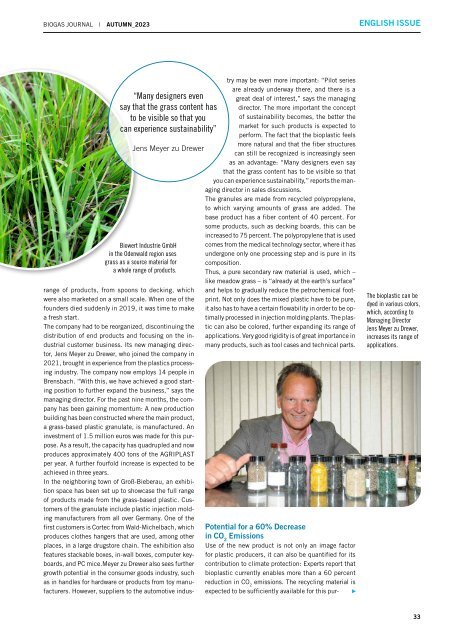Autumn 2023 EN
The German Biogas Association presents its autumn 2023 issue of the English BIOGAS journal.
The German Biogas Association presents its autumn 2023 issue of the English BIOGAS journal.
- No tags were found...
Create successful ePaper yourself
Turn your PDF publications into a flip-book with our unique Google optimized e-Paper software.
BIOGAS JOURNAL | AUTUMN_<strong>2023</strong> <strong>EN</strong>GLISH ISSUE<br />
“Many designers even<br />
say that the grass content has<br />
to be visible so that you<br />
can experience sustainability”<br />
Jens Meyer zu Drewer<br />
Biowert Industrie GmbH<br />
in the Odenwald region uses<br />
grass as a source material for<br />
a whole range of products.<br />
range of products, from spoons to decking, which<br />
were also marketed on a small scale. When one of the<br />
founders died suddenly in 2019, it was time to make<br />
a fresh start.<br />
The company had to be reorganized, discontinuing the<br />
distribution of end products and focusing on the industrial<br />
customer business. Its new managing director,<br />
Jens Meyer zu Drewer, who joined the company in<br />
2021, brought in experience from the plastics processing<br />
industry. The company now employs 14 people in<br />
Brensbach. “With this, we have achieved a good starting<br />
position to further expand the business,” says the<br />
managing director. For the past nine months, the company<br />
has been gaining momentum: A new production<br />
building has been constructed where the main product,<br />
a grass-based plastic granulate, is manufactured. An<br />
investment of 1.5 million euros was made for this purpose.<br />
As a result, the capacity has quadrupled and now<br />
produces approximately 400 tons of the AGRIPLAST<br />
per year. A further fourfold increase is expected to be<br />
achieved in three years.<br />
In the neighboring town of Groß-Bieberau, an exhibition<br />
space has been set up to showcase the full range<br />
of products made from the grass-based plastic. Customers<br />
of the granulate include plastic injection molding<br />
manufacturers from all over Germany. One of the<br />
first customers is Cortec from Wald-Michelbach, which<br />
produces clothes hangers that are used, among other<br />
places, in a large drugstore chain. The exhibition also<br />
features stackable boxes, in-wall boxes, computer keyboards,<br />
and PC mice.Meyer zu Drewer also sees further<br />
growth potential in the consumer goods industry, such<br />
as in handles for hardware or products from toy manufacturers.<br />
However, suppliers to the automotive industry<br />
may be even more important: “Pilot series<br />
are already underway there, and there is a<br />
great deal of interest,” says the managing<br />
director. The more important the concept<br />
of sustainability becomes, the better the<br />
market for such products is expected to<br />
perform. The fact that the bioplastic feels<br />
more natural and that the fiber structures<br />
can still be recognized is increasingly seen<br />
as an advantage: “Many designers even say<br />
that the grass content has to be visible so that<br />
you can experience sustainability,” reports the managing<br />
director in sales discussions.<br />
The granules are made from recycled polypropylene,<br />
to which varying amounts of grass are added. The<br />
base product has a fiber content of 40 percent. For<br />
some products, such as decking boards, this can be<br />
increased to 75 percent. The polypropylene that is used<br />
comes from the medical technology sector, where it has<br />
undergone only one processing step and is pure in its<br />
composition.<br />
Thus, a pure secondary raw material is used, which –<br />
like meadow grass – is “already at the earth’s surface”<br />
and helps to gradually reduce the petrochemical footprint.<br />
Not only does the mixed plastic have to be pure,<br />
it also has to have a certain flowability in order to be optimally<br />
processed in injection molding plants. The plastic<br />
can also be colored, further expanding its range of<br />
applications. Very good rigidity is of great importance in<br />
many products, such as tool cases and technical parts.<br />
Potential for a 60% Decrease<br />
in CO 2<br />
Emissions<br />
Use of the new product is not only an image factor<br />
for plastic producers, it can also be quantified for its<br />
contribution to climate protection: Experts report that<br />
bioplastic currently enables more than a 60 percent<br />
reduction in CO 2<br />
emissions. The recycling material is<br />
expected to be sufficiently available for this pur-<br />
The bioplastic can be<br />
dyed in various colors,<br />
which, according to<br />
Managing Director<br />
Jens Meyer zu Drewer,<br />
increases its range of<br />
applications.<br />
33

















